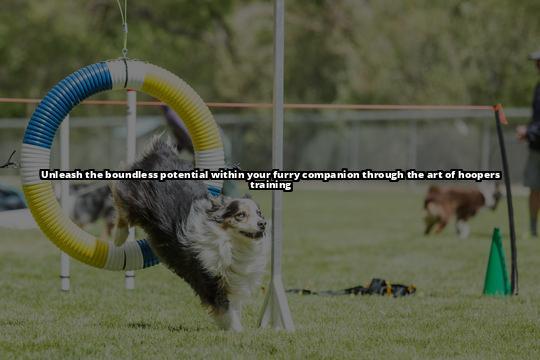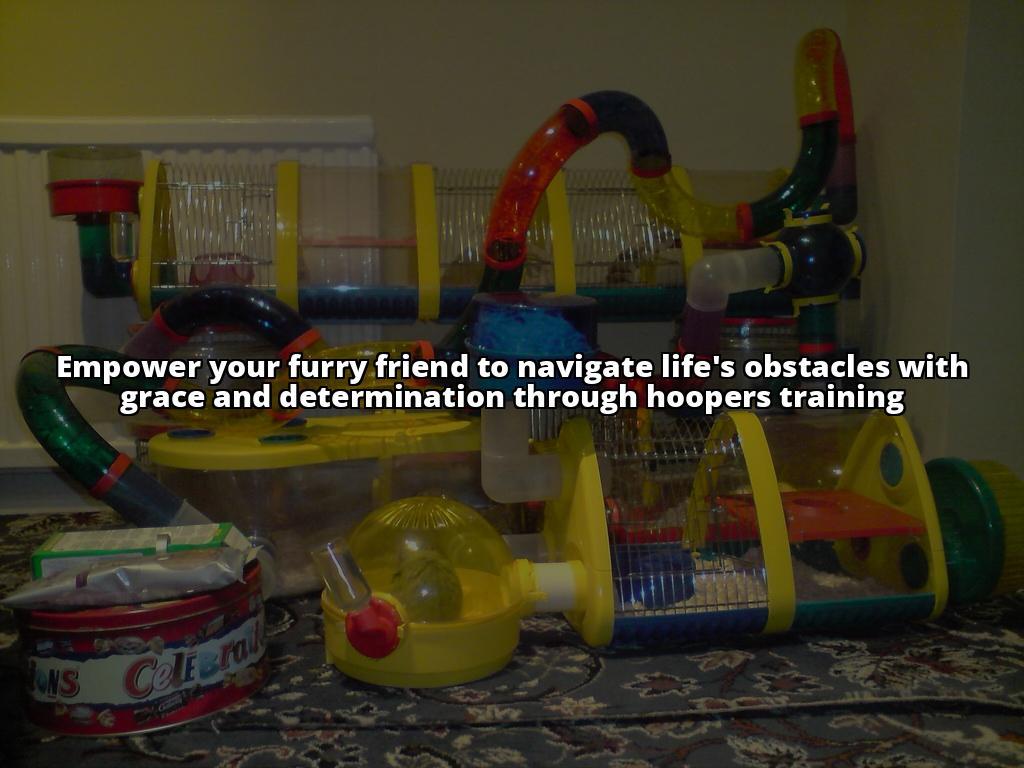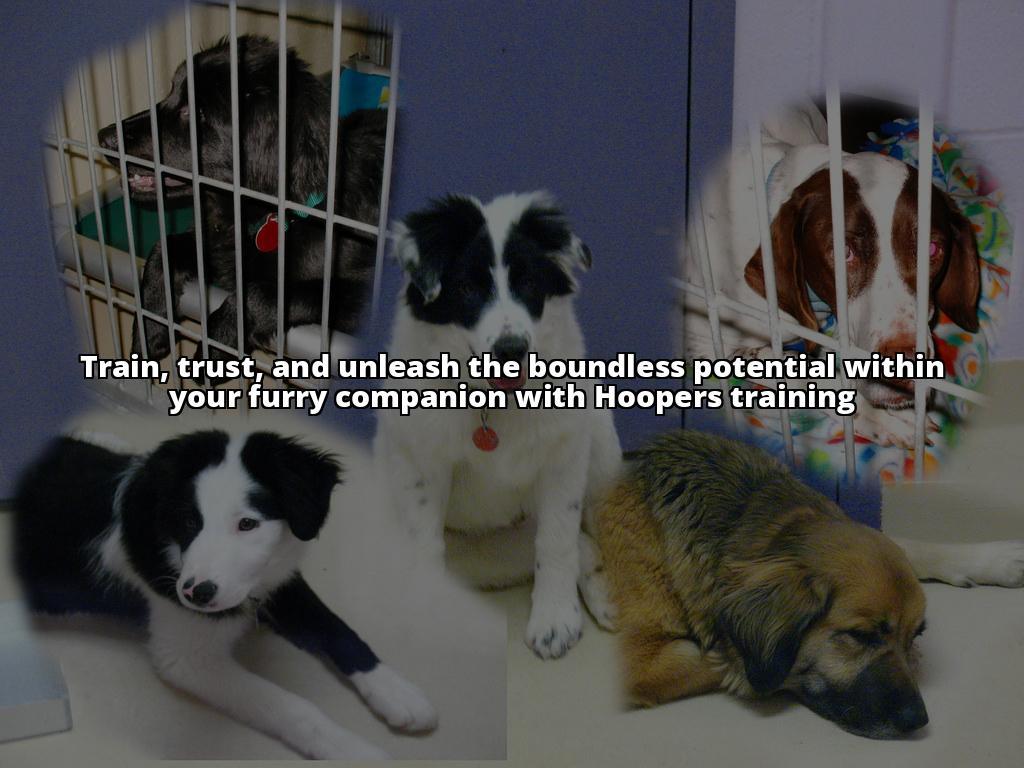Unleash Your Dog’s Potential with Hoopers Training
Learn Hoopers Training for Dogs
- Hoopers training provides physical and mental stimulation for dogs.
- It helps build confidence, trust, and communication between dogs and owners.
- The article covers equipment, techniques, common mistakes, and success stories related to hoopers training for dogs.
Understanding Hoopers Training for Dogs
Hoopers training is a fun and engaging activity that involves guiding your dog through a series of hoops, tunnels, and gates in a designated course. Unlike traditional agility training that involves jumping over obstacles, hoopers training focuses on ground-level obstacles, making it suitable for dogs of all ages and sizes.
Evolution of Hoopers Training
Originally developed as a low-impact sport for dogs with joint issues, hoopers training has evolved into a popular canine activity that promotes physical fitness, mental stimulation, and strengthens the bond between dogs and their owners.
Benefits of Hoopers Training for Canine Companions
Hoopers training offers a myriad of benefits for dogs, including improved physical fitness, mental stimulation, enhanced communication between dog and owner, and increased confidence and trust in the training process.

Benefits of Hoopers Training for Dogs
Physical and Mental Stimulation
Engaging in hoopers training provides dogs with the opportunity to exercise both their bodies and minds. The strategic navigation of obstacles and commands required in hoopers courses helps keep dogs mentally sharp and physically fit.
Confidence and Trust Building
As dogs successfully maneuver through hoopers courses with the guidance of their owners, they build confidence in their abilities and trust in their owners. This newfound confidence can translate into improved behavior and overall well-being.
Communication Enhancement Between Dog and Owner
Hoopers training requires clear communication between dogs and their owners. By working together to navigate the course, dogs learn to interpret their owner’s cues and signals, leading to improved communication and a stronger bond.
Relationship Bonding
The collaborative nature of hoopers training fosters a deeper connection between dogs and their owners. Through shared experiences and accomplishments, the bond between dog and owner is strengthened, leading to a more harmonious relationship.
Getting Started with Hoopers Training
Assessing Your Dog’s Readiness
Before embarking on hoopers training, assess your dog’s physical health and temperament to ensure they are ready for the activity. Consult with a veterinarian if necessary to address any concerns.
Suitable Training Environments
Choose a safe and spacious area free of distractions for hoopers training sessions. An enclosed space with non-slip flooring is ideal to prevent injuries and provide a conducive learning environment for your dog.
Selecting Hoopers Equipment
Invest in quality hoopers equipment such as hoops, tunnels, and gates that are suitable for your dog’s size and skill level. Ensure that the equipment is sturdy and safe for your dog to interact with.
Safety Measures
Prioritize safety during hoopers training by supervising your dog at all times, using positive reinforcement techniques, and incorporating breaks to prevent overexertion. Be mindful of your dog’s physical limitations and adjust the training accordingly.

Essential Equipment for Hoopers Training
Hoops, Tunnels, and Gates
The core components of hoopers training courses, hoops, tunnels, and gates, provide dogs with a variety of obstacles to navigate. These obstacles can be adjusted in height and width to accommodate different skill levels.
Non-Slip Flooring
Utilize non-slip flooring in the training area to ensure your dog’s safety while navigating the course. Avoid slippery surfaces that could cause accidents or discomfort for your dog during training sessions.
Reward System
Implement a rewarding system using treats, toys, or praise to reinforce positive behavior and motivate your dog during hoopers training. Positive reinforcement encourages dogs to engage with the training and helps build a strong foundation for learning.
Leash and Collar Essentials
Use a well-fitted leash and collar during hoopers training to maintain control and ensure your dog’s safety. Choose equipment that is comfortable for your dog to wear and allows for effective communication between you and your canine companion.

Step-by-Step Guide to Hoopers Training
Teaching Fundamental Commands and Skills
Start hoopers training by teaching your dog basic commands such as “sit,” “stay,” and “come,” to establish a foundation for future training sessions. Practice these commands in a controlled environment before progressing to hoopers-specific skills.
Introducing Hoops and Tunnels
Gradually introduce your dog to hoops and tunnels by encouraging them to walk through the obstacles using positive reinforcement. Use treats or toys to guide your dog through the course and make the experience enjoyable.
Navigating the Course
Guide your dog through a simple hoopers course, focusing on clear communication and encouragement. Break down the course into manageable sections and reward your dog for successfully completing each segment.
Progression and Difficulty Levels
As your dog becomes more comfortable with hoopers training, gradually increase the difficulty level of the course by adding more obstacles or challenging sequences. Monitor your dog’s progress and adjust the training to match their skill development.
Common Mistakes to Avoid in Hoopers Training
Avoiding Rushed Training
Take your time with hoopers training and avoid rushing through exercises. Allow your dog to learn at their own pace and provide ample opportunities for practice and reinforcement.
Positive Reinforcement Techniques
Focus on positive reinforcement to motivate your dog during training sessions. Avoid using punishment or harsh corrections, as this can undermine your dog’s confidence and willingness to participate.
Course Complexity Management
Ensure that the hoopers course is appropriately challenging for your dog’s skill level. Avoid overwhelming your dog with complex sequences or obstacles that may lead to frustration or confusion.
Recognizing Stress Signals
Be attentive to your dog’s body language and behavior during training sessions. Look for signs of stress or anxiety, such as panting, pacing, or avoidance, and adjust the training to alleviate any discomfort your dog may be experiencing.
Advanced Hoopers Training Techniques
Speed and Agility Development
Enhance your dog’s speed and agility through advanced hoopers training exercises that focus on quick decision-making and precise movements. Practice directional cues and obstacle navigation to improve your dog’s performance.
Distance Handling and Directional Cues
Master distance handling techniques to guide your dog through hoopers courses from a distance. Use verbal and visual cues to direct your dog around obstacles and encourage independent decision-making.
Complex Courses and Sequences
Challenge your dog with complex hoopers courses that require strategic planning and precise execution. Incorporate tight turns, obstacle combinations, and speed variations to keep your dog engaged and mentally sharp.
Obstacle Challenges
Introduce new obstacles and challenges to expand your dog’s hoopers training repertoire. Incorporate novel elements such as elevated platforms, weaving poles, or balancing obstacles to test your dog’s skills and coordination.

Making Hoopers Training Enjoyable for Your Dog
Incorporating Play and Games
Infuse play and games into hoopers training to make the experience enjoyable for your dog. Use interactive toys, tunnels, and obstacles to create a stimulating and fun training environment that keeps your dog motivated.
Creating a Positive Environment
Establish a positive training atmosphere by maintaining a calm and encouraging demeanor during sessions. Use praise, treats, and affection to reinforce good behavior and create a sense of excitement and enthusiasm around hoopers training.
Course Variation
Keep hoopers training interesting by varying the course layout, obstacles, and challenges. Introduce new elements regularly to prevent boredom and maintain your dog’s engagement and focus during training sessions.
Celebrating Achievements
Celebrate your dog’s accomplishments and progress in hoopers training with praise, rewards, and special treats. Acknowledge your dog’s hard work and dedication to the training process to reinforce positive behavior and build confidence.
Troubleshooting Common Hoopers Training Issues
Overcoming Obstacles
Address training obstacles by breaking down complex tasks into manageable steps for your dog. Provide clear guidance and support to help your dog overcome challenges and build confidence in their abilities.
Enhancing Focus and Engagement
Improve your dog’s focus and engagement during hoopers training by minimizing distractions and creating a structured learning environment. Use high-value rewards and interactive training techniques to maintain your dog’s interest and motivation.
Improving Directional Cues
Refine your dog’s understanding of directional cues by practicing consistent commands and gestures during hoopers training. Use visual aids such as target sticks or markers to reinforce directional cues and enhance your dog’s responsiveness.
Addressing Fear and Anxiety
If your dog exhibits signs of fear or anxiety during hoopers training, address these issues with patience and understanding. Create a safe and supportive environment for your dog to build confidence and trust in the training process gradually.
Integrating Hoopers Training into Your Dog’s Routine
Establishing Training Goals
Set clear training goals for hoopers training that align with your dog’s abilities and interests. Define achievable milestones and track your dog’s progress to stay motivated and focused on continuous improvement.
Consistent Schedule
Maintain a consistent training schedule for hoopers sessions to establish a routine and reinforce learning. Regular practice helps solidify skills and behaviors, leading to long-term success in hoopers training.
Daily Integration
Incorporate hoopers training into your dog’s daily routine to provide regular mental and physical stimulation. Short, frequent training sessions throughout the day help keep your dog engaged and promote ongoing skill development.
Monitoring Progress
Monitor your dog’s progress in hoopers training by tracking performance, behavior, and skill development over time. Adjust the training regimen as needed to address areas of improvement and ensure continued growth and success.
Contrasting Hoopers and Agility Training
Training Objectives
Hoopers training focuses on ground-level obstacles and distance handling, while agility training emphasizes jumping and speed through elevated obstacles. Each training style offers unique challenges and benefits for dogs with different skill sets and preferences.
Unique Skills
Hoopers training develops skills such as distance handling, strategic planning, and obstacle navigation, whereas agility training hones skills in jumping, weaving, and rapid course completion. Both disciplines require focus, coordination, and teamwork between dog and owner.
Complementary Benefits
Combining hoopers and agility training can provide a well-rounded fitness and mental stimulation regimen for dogs. The varied challenges and skills required in each discipline complement each other, offering a comprehensive training experience for canine companions.
Tailoring Training to Your Dog’s Needs
Tailor hoopers and agility training to suit your dog’s individual strengths, preferences, and physical capabilities. Modify the training environment, obstacles, and exercises to create a customized training program that maximizes your dog’s potential and enjoyment.

Success Stories of Hoopers Training
Real-Life Examples
Explore real-life success stories of dogs who have excelled in hoopers training and achieved remarkable feats through dedication and perseverance. Learn from these inspirational stories to motivate and inspire your own training journey with your dog.
Testimonials
Read testimonials from dog owners who have witnessed the positive impact of hoopers training on their canine companions. Discover firsthand accounts of improved behavior, enhanced communication, and strengthened bonds resulting from engaging in hoopers training.
Progress Showcases
Celebrate the progress and achievements of dogs participating in hoopers training through showcases and competitions. Witness the growth and development of dogs as they master new skills, overcome challenges, and showcase their talents in hoopers courses.
Inspirational Stories
Draw inspiration from the heartwarming tales of dogs who have found joy, confidence, and fulfillment through hoopers training. Embrace the transformative power of training and the profound bond that can be forged between dogs and their owners through shared experiences.
Success Story: Journey to Confidence and Trust with Hoopers Training
A Newfound Bond
As a passionate dog owner, Sarah was always looking for ways to deepen the connection with her furry companion, Max. Feeling that traditional obedience training was becoming repetitive, she decided to explore the world of Hoopers training. Starting with basic commands and gradually introducing hoops and tunnels, Sarah noticed a remarkable transformation in Max’s behavior.
Building Confidence
Through consistent practice and positive reinforcement, Max’s confidence soared as he navigated through the Hoopers course with ease. Sarah was amazed at the level of trust and communication they developed during training sessions. Max’s tail wagging enthusiastically after each successful run became a testament to the strong bond they had formed through the Hoopers training experience.
Overcoming Challenges
While they faced obstacles and setbacks along the way, Sarah’s dedication to understanding Max’s needs and adjusting the training approach accordingly proved invaluable. By recognizing Max’s stress signals and providing a supportive environment, they overcame challenges together, emerging stronger and more connected than ever before.
Celebrating Achievements
As they progressed to more advanced techniques, Sarah and Max celebrated each milestone, no matter how small. From conquering complex courses to mastering directional cues, their shared victories in Hoopers training not only brought them joy and satisfaction but also strengthened their relationship in ways Sarah never thought possible.
FAQ About Hoopers Training
Addressing Concerns and Queries
Address common concerns and questions related to hoopers training, such as safety precautions, training tips, and equipment recommendations. Provide informative answers to help dog owners navigate the world of hoopers training with confidence.
Clarifying Misconceptions
Dispell misconceptions surrounding hoopers training, such as its suitability for specific dog breeds or age groups. Clarify any misunderstandings and showcase the inclusive nature of hoopers training for dogs of all backgrounds and abilities.
Expert Answers
Offer expert insights and advice on hoopers training from seasoned trainers and canine behavior specialists. Draw on professional knowledge and experience to provide valuable guidance on best practices, troubleshooting techniques, and training strategies.
Encouraging Further Learning
Encourage dog owners to continue their education and exploration of hoopers training through workshops, classes, and online resources. Foster a community of learning and support for individuals seeking to deepen their understanding of this rewarding canine activity.
Resources for Hoopers Training
Recommended Books and Websites
Discover recommended books, websites, and online resources that offer valuable information and guidance on hoopers training. Explore training manuals, instructional videos, and expert tips to enhance your knowledge and skills in this exciting canine sport.
Training Classes
Enroll in hoopers training classes led by experienced instructors who can provide hands-on guidance and support. Join group sessions or private lessons to refine your training techniques and advance your dog’s skills in a structured and supportive environment.
Community Connections
Connect with fellow hoopers enthusiasts and dog owners through community events, forums, and social media groups. Share experiences, ask questions, and build relationships with like-minded individuals who share your passion for hoopers training and canine sports.
Professional Guidance
Seek professional guidance from certified dog trainers or behaviorists who specialize in hoopers training. Consult with experts to address specific training challenges, refine your techniques, and develop a customized training plan tailored to your dog’s needs and abilities.
Conclusion
Key Points of Hoopers Training
Hoopers training offers a rewarding and enriching experience for dogs and their owners, promoting physical fitness, mental stimulation, and relationship bonding. By engaging in hoopers training, dogs can unleash their full potential and thrive in a supportive and engaging training environment.
Reinforcing Benefits
The benefits of hoopers training extend beyond physical exercise to include confidence building, communication enhancement, and skill development. Through consistent practice and positive reinforcement, dogs can achieve remarkable progress and enjoy a fulfilling training journey.
Encouraging Growth
Embrace the growth and learning opportunities inherent in hoopers training, both for dogs and their owners. By fostering a supportive and encouraging training environment, you can nurture your dog’s talents, strengthen your bond, and embark on a rewarding journey of skill development and achievement.
| Equipment | Description |
|---|---|
| Hoops, Tunnels, Gates | Core components of hoopers courses for navigating obstacles |
| Non-Slip Flooring | Ensures safety and stability for dogs during training sessions |
| Reward System | Utilizes treats, toys, or praise to reinforce positive behavior |
| Leash and Collar | Essential for control and communication between owner and dog during training sessions |
Reasoning: This table summarizes the essential equipment needed for hoopers training, highlighting their roles in creating a safe and effective training environment for dogs.
Step-by-Step Guide to Hoopers Training
Table:
| Step | Description |
|---|---|
| Teaching Fundamental Commands | Establish basic commands like “sit,” “stay,” and “come” to lay the groundwork for hoopers training |
| Introducing Hoops and Tunnels | Gradually familiarize dogs with hoops and tunnels using positive reinforcement |
| Navigating the Course | Guide dogs through simple hoopers courses, focusing on clear communication and encouragement |
| Progression and Difficulty Levels | Increase the challenge level as dogs become more comfortable, monitoring progress and adjusting training |
Conclusion
Embrace and celebrate the wonderful journey of training and bonding with your dog through hoopers. Cherish every milestone, achievement, and shared moment that strengthens the unique connection between you and your furry friend. Join us at our shop to discover a range of hoopers training equipment and accessories to enhance your training sessions and create lasting memories with your canine companion. Let’s make every training session special and full of joy!


Leave a Reply